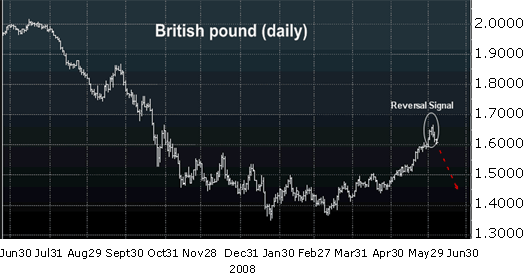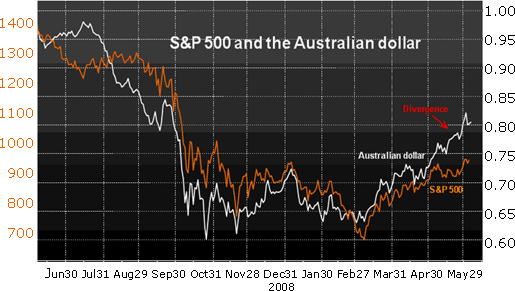Will the British Pound Get Pounded?
Currencies / British Pound Jun 06, 2009 - 08:28 PM GMT Bryan Rich writes: When financial markets were on the way down, risk aversion reigned and every investment that was deemed risky crashed. The U.S. dollar and 10-year Treasuries did well as global investors fled to safety.
Bryan Rich writes: When financial markets were on the way down, risk aversion reigned and every investment that was deemed risky crashed. The U.S. dollar and 10-year Treasuries did well as global investors fled to safety.
But for the last three months this trade has been in retracement mode. And the further it has retraced, the more it has fueled optimism in the outlook for a recovery.
Stocks have been rising. Foreign currencies have climbed. Even commodities finally showed some life, and when they did … they bounced strongly. As a result, the U.S. dollar and 10-year Treasuries have been sold.
Wednesday, though, was a key day in the financial markets.
That day may have marked …
The Top in This Aggressive Retracement Period — At Least For the British Pound …
 |
| Last year, British shoppers were flocking to the U.S., taking advantage of the pound’s strength. |
Just last year the pound was soaring to all-time highs against the dollar. And UK residents were enjoying their buying power in the States … snapping up U.S. real estate and traveling for shopping sprees in places like New York City.
However, when the financial crisis hit the U.S., it was quickly found that the UK was just as exposed, if not more so. And when it was finally determined that many countries were not “decoupled” from the U.S., but were in fact highly interconnected, the pound and other currencies came tumbling down.

Source: Bloomberg
The chart above shows the severity of the pound’s crash. Six years of strength in the pound (versus the dollar) was given back in 14 short months!
But in the last three months the pound has aggressively regained 23 percent of this fall.
As this retracement trade across risky assets turned into a recovery theme for the markets, the policy actions in the UK coincided nicely, beginning to show some effects and glimpses of economic improvement.
Nevertheless, in the face of this strength, the pound has been dealt two harsh blows …
Two weeks ago Standard and Poors downgraded the outlook of the UK’s AAA credit rating. Yet the pound proceeded to rally over 7 percent in the following weeks.
Then a political scandal struck when members of Prime Minister Gordon Brown’s cabinet were exposed for personal spending jaunts with taxpayer money. Yet the pound continued to rally.
Why?
It had very little to do with specific interest in the pound. But it had everything to do with the across-the-board retracement of the collapse in risky assets that took place from mid-2008 to March 2009.
Risk Aversion Trade — Round #2
This week, the wholesale retracement in financial markets reached some very significant inflection points …
The U.S. stock market, which has led this retracement, steadily climbed higher and higher and fed into an optimism that has fed back into the stock market. And when the stock market rises and optimism rises, so does confidence about the economic outlook. And voila, we have green shoots.
But in all likelihood, this feel-good rally has run its course. The U.S. stock market has climbed 42 percent in 13 weeks. What’s more, it has now reached its 200-day moving average AND significant long-term technical resistance.
 |
| On Wednesday, a key reversal signal flashed. Now the pound is feeling the heat. |
When confidence is being manufactured by a rising stock market in simple retracement mode during the worst economic period since the Great Depression … look out below!
If there is one glaring characteristic of this financial market environment, it’s the tight relationship that has developed between markets in global crisis mode.
In other words, when the U.S. stock market runs into a wall, so will practically everything else. You could see this very clearly on Wednesday when sharp sell-offs took place in currencies, commodities and stocks all at the same time.
For currencies, when this rally subsides the biggest gainers are likely to experience the sharpest declines. As for the pound, it’s already feeling the heat.
Take a look at the following chart and you’ll see a clear reversal signal …

Source: Bloomberg
I’m seeing the same kind of foretelling technical signals in the Australian dollar, which was the biggest mover among major currencies on the way up.
The Aussie dollar has climbed 31 percent in three months, tracking the U.S. stock market closely all along the way as you can see in the chart below …

Source: Bloomberg
Bottom line: We could be entering round two of the risk aversion trade. And if we are, you can be sure that all of the negative issues and threats facing economies will come back into the crosshairs.
That could mean major downside for currencies like the British pound and the Aussie dollar.
Regards,
Bryan
This investment news is brought to you by Money and Markets . Money and Markets is a free daily investment newsletter from Martin D. Weiss and Weiss Research analysts offering the latest investing news and financial insights for the stock market, including tips and advice on investing in gold, energy and oil. Dr. Weiss is a leader in the fields of investing, interest rates, financial safety and economic forecasting. To view archives or subscribe, visit http://www.moneyandmarkets.com .
Money and Markets Archive |
© 2005-2022 http://www.MarketOracle.co.uk - The Market Oracle is a FREE Daily Financial Markets Analysis & Forecasting online publication.



